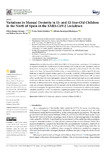Variations in Manual Dexterity in 11- and 12-Year-Old Children in the North of Spain in the SARS-CoV-2 Lockdown

Ver/
Use este enlace para citar
http://hdl.handle.net/2183/31518
A non ser que se indique outra cousa, a licenza do ítem descríbese como Atribución 4.0 Internacional
Coleccións
- Investigación (FEDU) [938]
Metadatos
Mostrar o rexistro completo do ítemTítulo
Variations in Manual Dexterity in 11- and 12-Year-Old Children in the North of Spain in the SARS-CoV-2 LockdownData
2022Cita bibliográfica
Ramos-Álvarez, O.; Arufe-Giráldez, V.; Sanmiguel-Rodríguez, A.; Navarro-Patón, R. Variations in Manual Dexterity in 11- and 12-Year-Old Children in the North of Spain in the SARS-CoV-2 Lockdown. Int. J. Environ. Res. Public Health 2022, 19, 7162. https://doi.org/10.3390/ ijerph19127162
Resumo
[Abstract] Between March and June 2019, the SARS-CoV-2 virus broke out in Spain. The lockdown
in response entailed the modification of certain habits in the infant–juvenile population, such as
those related to the practice of physical activity and the implications derived from it. The aim of this
study was to learn the impacts that lockdown had on manual dexterity in children aged 11–12 years.
Methods: A total of 50 Spanish children aged 11–12 years (M = 11.40; SD = 0.50) participated, 33 (66%)
boys and 17 (34%) girls. The Movement Assessment Battery for Children 2 (Movement ABC-2) and an
ad hoc questionnaire for socio-demographic data and other relevant information were administered
for the data collection. Results: There are significant differences (p < 0.05) in the results for the manual
dexterity variables measured by the peg turning and line drawing tests as well as by the measured,
scalar and percentile dimension scores for manual dexterity between before and after the lockdown
in both boys and girls. No significant differences were found in measurements related to the triangle
assembly variable (p = 0.125). Conclusions: A significant negative impact of SARS-CoV-2 lockdown
on manual dexterity values was evident in boys and girls aged 11–12 years
Palabras chave
SARS-CoV-2
Lockdown
Physical activity
Children
MABC-2
Lockdown
Physical activity
Children
MABC-2
Descrición
This article belongs to the Special Issue "Physical Education: Present and Future"
Versión do editor
Dereitos
Atribución 4.0 Internacional






